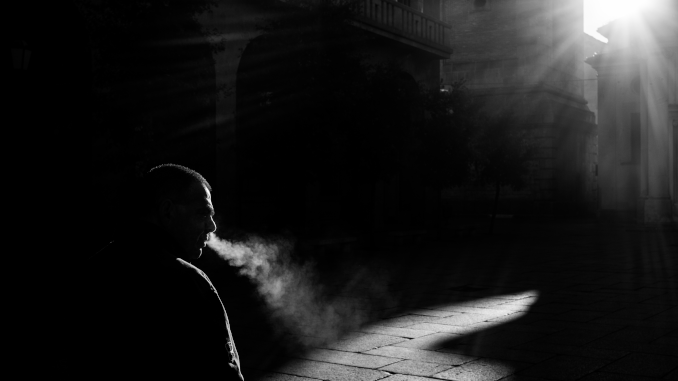
Welcome back to Noir Side Street, where men are Men, women are Women, and smoking is King. Or something.
Today’s film is “Bob le Flambeur,” which means, “Bob, the Gambler.” Made in 1956, the movie stars Roger Duchesne (Bob), Isabel Corey (Anne), Daniel Cauchy (Paolo), Guy Decomble (Inspector Ledru), and Andre Garet (Roger). Written and directed by Jean-Pierre Melville (billed only as “Melville” in the film credits), with cinematography by Henri Decaë.
Instead of giving you a complete synopsis of the film, I’ll point you to the Wikipedia synopsis, which helped me get through the movie as I watched it. (While I enjoyed subtitled foreign films as a younger person, I find that reading them now takes away from enjoying the overall effect of the film; I’m paying too much attention to reading that I miss subtle depictions of character and plot as well as ambience, which is essential to the storytelling of film noir. And since the film represents a different culture from my own, there are no doubt things happening which slip past my notice, that a native-speaking audience would easily pick up.) Which is why “cheating” and reading a synopsis for this film, rather than watching it without that was really helpful to figure out who was who and what was going on.
And while Tiff and I were searching for screenshots of the film to illustrate the visual aspects of it (sadly, we didn’t come across anything that was free to use here), I did find a cool blog post where the author shows stills from the film and matches them up to the same locations as they appear today, complete with the street address (there are a few film stills he hasn’t matched with the corresponding real location). Many of the locations are little changed from the way they appear in the film, and it would be kind of fun to follow the characters through their movement in Paris’s demimonde.
I really enjoyed this film; it really ticked all my boxes for what a film noir is or should be. It has the visual atmosphere of noir down cold, from the very opening shot, which is nighttime on a road somewhere outside a fog enshrouded Paris. This shot immediately clues us into the fact we’re not in America, yet we’re somehow in familiar territory anyway.
I don’t normally care for noir films that are caper/criminal movies, as I usually don’t like any of the characters. But Bob was very relatable, a decent man who had his own code, who just wanted to enjoy his life. He’s described early in the film as a “young old man,” which I took to mean that he still lives by the seat of his pants, like a carefree young man; but he really can’t afford to be so careless, now that’s he’s growing old.
But as we discussed last time, if noir is a cautionary tale warning viewers to stay on the straight and narrow, we know Bob is going to fall. And, boy, does he fall. Bob’s main vice is, apparently, gambling away the proceeds he stole during a bank robbery, twenty years previous. He is down to his last 700,000 francs (which sounds like a heckuva lot more money than it is), which he takes to bet on a horse race. He wins, and goes to the casino in Deauville, along with his old friend Roger; and that’s when his fate is sealed. Bob loses everything he won at the racetrack, except for 200,000 francs. Meanwhile, Roger runs into an old army friend who works at the casino as a croupier. The croupier happens to mention how the night before the Grand Prix, the casino’s safe holds 800 million francs at 5:00 AM. When Bob hears about this later, once they return to Paris, he’s immediately sold on the idea of pulling off the greatest score of his life. Bob promises his friend that he won’t gamble until the job is finished. And breaking this promise, ironically, is what saves him at the end of this story.
As with every caper film pretty much ever, things don’t go nearly as smoothly as planned, because a couple of the confederates get a little careless about saying more than they should, and, well… you can guess the rest. But there’s a pretty satisfying twist at the end, which suggests Bob will get away with his actions, and you really want him to. At least, I did.
As with last week’s film, we don’t have a typical femme fatale, but they’re both equally lethal to a couple of the men, who don’t live to see the end of the movie. Neither of the women are bad, and neither did anything (much) to encourage these men; the men are caught by their own need or greed and end up being the authors of their own fate. In a sense, if anyone is a real femme fatale in this movie it’s the croupier’s wife, who, just like Lady McBeth, leads her husband into actions he really shouldn’t take, betraying his friends.
Be sure to look for Eddie Mueller’s Noir Alley intro and exit for this film on YouTube. There’s a really interesting real-life story of the actor playing Bob, where art imitates life.
I give “Bob le Flambeur” 4.5 out of 5 unfiltered cigarette puffs.
As always, this is an open thread, so feel free to talk about whatever you like. Keep puffing, my Blender peeps!
